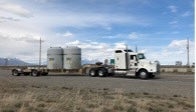
Workers at the US Idaho National Laboratory (INL) Site have completed the single largest demolition project in Idaho Clean-up Project history three months ahead of schedule and under budget, the US Department of Energy (DOE) Office of Environmental Management (EM) reported.
More than 520,000 square feet of building space has been demolished – a 2024 priority project. Decontamination and demolition (D&D) crews with clean-up contractor Idaho Environmental Coalition (IEC) removed the last of 10 steel-framed, soft-sided buildings – nine for waste exhumation and one for waste storage – that had been constructed over a 97-acre Cold War-era landfill called the Subsurface Disposal Area.
The landfill accepted INL Site-generated radioactive and hazardous waste from 1952, as well as waste from the former Rocky Flats Plant near Denver, Colorado, and other waste generator sites from 1954 to 1970. In 2008, DOE, the state of Idaho and the Environmental Protection Agency (EPA) agreed to exhume targeted radioactive and hazardous waste from the landfill. The waste, from nine areas of the landfill covering a total of 5.69 acres, included filters and moulds, solidified sludge and a reactive uranium material called “roaster oxides”. The exhumation project was completed 18 months early and, to date, more than 90% of the exhumed waste has been shipped out of Idaho for permanent disposal.
Transuranic waste exhumed from the Subsurface Disposal was placed in TRUPACT containers and sent for disposal at the Waste Isolation Pilot Plant located 33 miles southeast of Carlsbad, New Mexico, in the Chihuahuan Desert, far from major population centres. Waste is disposed of in a set of panels located nearly half a mile below the surface in a deep geologic salt bed formed 250 million years ago. The facility began operation in 1999.
Following completion of waste exhumation at two of the enclosures, the buildings were repurposed for crews to reduce the size of waste boxes from Rocky Flats and large gloveboxes from the former Mound Site in Miamisburg, Ohio. Later, the enclosures were used to treat and repackage sludge waste originating from Rocky Flats. A third enclosure was used to condition the roaster oxides from Rocky Flats before workers at the facility began targeted waste exhumation.
To prepare for the demolition of each enclosure, crews removed internal equipment and performed extensive decontamination activities on the highly contaminated structures to allow for safe demolition. They covered the exhumation footprint with clean soil and removed the facility ventilation system. Final steps included applying fixatives, removing the exterior skin and weakening the support components of the buildings through an engineered approach. Large bulldozers pulled the skeletal frames over. Following the sizing of the metal structures with heavy equipment, the contaminated debris was buried, and clean cover material was placed over each former waste exhumation footprint.
Eventually an engineered cover containing native materials will be constructed over the entire landfill to ensure long term protection of the underlying Snake River Plain Aquifer. “Removing these enclosures from the Subsurface Disposal Area puts us a step closer to closing the final chapter on the Subsurface Disposal Area landfill,” EM Idaho Clean-up Project Manager Mark Brown said. “This was a combined effort by a very talented contractor workforce, with effective management by our cleanup contractor, IEC, and excellent oversight by my federal staff.”






